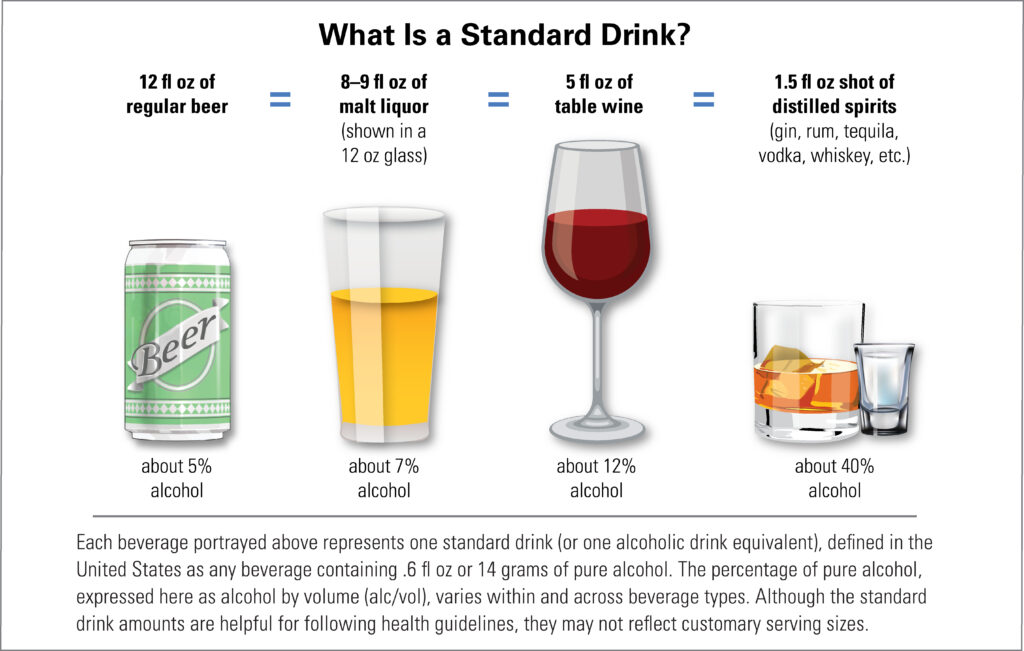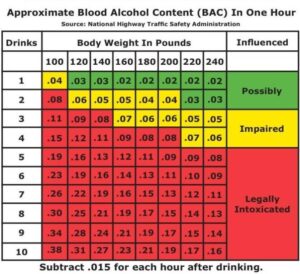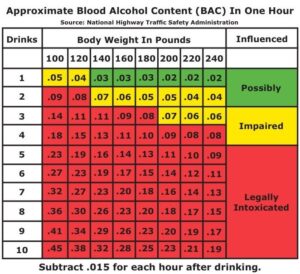If you choose to drink, drink responsibly. You can reduce your risk of an alcohol-related problem and still have fun with just a little education.

When setting your drinking limits, it’s important to know what a standard drink of alcohol is. A “standard drink” refers to an alcoholic beverage that your body can process in about one hour.
How much you pour for a standard drink depends on how concentrated your alcoholic beverage is. The image above represents some general rules of thumb for what a standard drink is for different concentrations of alcohol. Not all alcoholic beverages fit into these neat categories; some products contain higher concentrations of alcohol. To calculate the standard drink size for different alcohol products outside of the concentrations above, check out this calculator.
Additional Factors to Consider When Setting Your Limits
We recommend trying to stick to about one standard drink per hour to reduce your risk of negative outcomes. Below are some additional recommendations to consider when setting your personal drinking limits if you choose to drink.
According to the Centers for Disease Control and Prevention (CDC) and the Dietary Guidelines for Americans, moderate drinking is defined as having no more than one drink per day for biological females (not to exceed seven drinks in a week) and no more than two drinks per day for biological males (one drink per hour and not to exceed 14 drinks in a week), on days a person chooses to drink. Moderate drinking is associated with fewer negative health outcomes.
Binge Drinking is considered a riskier form of drinking, in which a person consumes enough alcohol to reach a Blood Alcohol Concentration (BAC), of 0.08% or more.
For biological females, this typically occurs when a person has 4 or more drinks in a 2-hour period. For biological males, this typically occurs when a person has 5 or more drinks in a 2- hour period.
When setting your personal drinking limits, we recommend avoiding binge drinking to limit your risk of negative outcomes, including riskier sexual behaviors, accidents/injuries, and organ damage over time.
Alcohol is considered a toxin to the body. Your liver helps process alcohol at a fixed rate to remove the toxin from your body. When there is a large amount of alcohol in the body the liver cannot keep up and a person’s body can begin to shut down. It is important to set limits and pace yourself to help prevent alcohol poisoning.
If you suspect someone is suffering from alcohol poisoning, it’s important to call emergency services. If you are off campus, call 911. If you are on campus, call EST at (314) 935-5555.
BAC is a measurement of how much alcohol is in a person’s bloodstream. BAC indicates how impaired a person is from drinking.
It’s important to know that a few factors impact how quickly a person’s BAC can rise.
- Food- if a person drinks on an empty stomach, the alcohol will be absorbed into their bloodstream faster. This results in a sudden spike in BAC.
- Rate of Consumption- the faster a person drinks, the quicker their BAC will rise. This is because the liver needs time to process the alcohol (one hour per standard drink). Drinking games can be dangerous, as they encourage individuals to drink a lot of alcohol in a short amount of time.
- Weight- people who weigh less will have a higher BAC than those who weigh more, even if they drink the same amount of alcohol.
- Sex Assigned at Birth- Biological females generally have more body fat and less of an enzyme that helps process alcohol, so a biological female will have a higher BAC than a biological male even if they drink the same amount of alcohol.
*A person can develop a tolerance to alcohol. This would lead a person to need to drink more alcohol to feel the effects they used to feel. Tolerance can be dangerous, as your BAC still rises at the same rate even if you don’t feel as impaired.
The charts below can be used to help estimate what your BAC might be depending on your sex assigned at birth, weight, and how many drinks you have consumed. You can also see some commonlyl-used medications and their interactions on this chart by the National Institute on Alcohol Abuse and Alcoholism (NIAAA) for what you may experience at different BAC levels.

One drink equals 1.5 oz. of 80 proof liquor (40% alcohol), 12 oz. beer (5% alcohol), or 5 oz. wine (12% alcohol).

One drink equals 1.5 oz. of 80 proof liquor (40% alcohol), 12 oz. beer (5% alcohol), or 5 oz. wine (12% alcohol).
If you are taking prescribed or over-the-counter medications, talk with your doctor or do some online research about how alcohol impacts its effectiveness. For many medications, alcohol can reduce its impact on your body.
Mixing alcohol with certain medications can intensify impairment and cause side effects like vomiting, loss of consciousness, and breathing difficulties. It can also increase your risk for internal bleeding. Mixing certain medications with alcohol can also increase your risk of overdosing. You can see some commonly used medications and their interactions with alcohol on the National Institute on Alcohol Abuse and Alcoholism website.
Responsible drinking means taking steps to reduce your risk for experiencing an alcohol-related problem.For example:
- Eat before and while you drink: Food slows the rate of alcohol absorption.
- Reduce the rate at which you drink. Sip, don’t gulp!
- Keep track of how much you are drinking. Apps such as Alcodroid Alcohol Tracker (for androids) or Drink Control (iPhone), can be helpful.
- Avoid mixing alcohol with other drugs; mixing substances can be dangerous.
- Always plan a sober way home, whether that be by a rideshare or a designated driver who has consumed no alcohol.
- Have only one drink per hour and alternate booze with nonalcoholic beverages to pace yourself and stay hydrated.
- Do not engage in sexual activity under the influence of alcohol; your decision-making skills and judgment are impaired. Consider a “rain check” for a later date.
The Substance Abuse and Mental Health Services Administration (SAMHSA), recognizes several signs that might indicate a person is drinking too much.
- You drink more or for a longer period of time than you intended.
- You attempt to cut down/stop drinking, but cannot.
- You continue to drink even though it causes health issues.
- Loved ones have made comments about your drinking habits.
- Your drinking interferes with daily activities and relationships.
- You have experienced withdrawal symptoms when not drinking (ex: shakiness, sweating, anxiety, insomnia, etc.).
If you think that you or someone you know might have an alcohol problem, it is important to see a doctor or other health care provider right away.
Talking with someone who may have a drinking problem or has had too much to drink can be difficult. Remember, it is a process. Preparing yourself, getting the proper support you need, and understanding what you can expect from the interaction can decrease some of your fear and make you feel more confident. Here are some things that you can do before, during, and after a conversation with a friend:
Before the conversation:
- Become informed about the problem.
- Examine your own values and attitudes about the problem and about your friend.
- Develop a plan to communicate your concern:
- Should you be the person to intervene?
- Who else should be involved?
- What are the appropriate referral sources?
- Know the basic facts regarding drinking behaviors and use these facts to substantiate your concern (see below).
- Expect to encounter excuses, promises of behavior change, attempts to change the conversation, and attempts to pass the behavior off as “no big thing.”
During the conversation:
- Communicate your care and concern for your friend.
- State specific examples of problem behaviors.
- Do not label or criticize.
- Maintain the offensive; don’t let your friend put you on the defensive about your own drinking behavior.
- Stick to the issue: Remember the problem is alcohol and the resulting behavior.
- Mention choices: Remind the person they need to take action, but they have options.
After the conversation:
- Provide ongoing support.
- Help your friend make and keep referral appointments.
- Do not get discouraged if the intervention does not work. If your friend is not ready to make a change there is little you can do.
- Get help for yourself if you are negatively affected by the confrontation or your relationship with your friend.
- Email Health Promotion to schedule a 1:1 meeting with the Alcohol and Other Drug Health Educator to discuss lowering your risk.
- WashU has a recovery group for students curious about or in recovery.
- The Center for Counseling and Psychological Services offers counseling sessions and can help connect students to community resources.
- TimelyCare offers on-demand medical and mental health support. Ready to download the app?
- Uncle Joe’s Peer Counseling and Resource Center has a 24-hour hotline at 314-935-5099. If you wish to speak with someone in person, their office is in the basement of Gregg Hall, 10 p.m.-1 a.m. nightly during semesters.
- Go Ask Alice has many Q&As for common problems facing college students.
- There is more information on alcohol and substance abuse at FamilyDoctor.